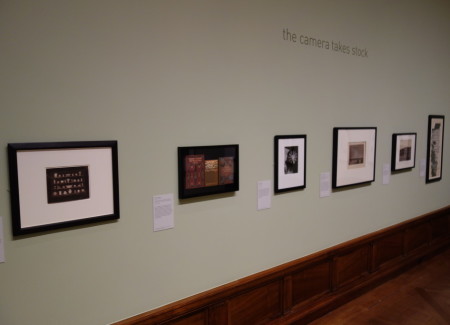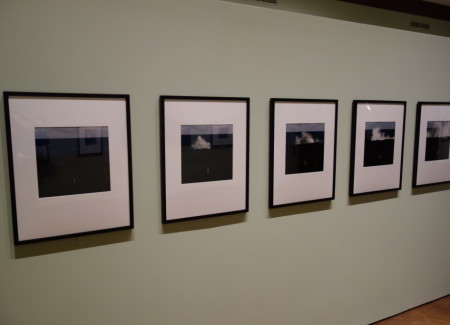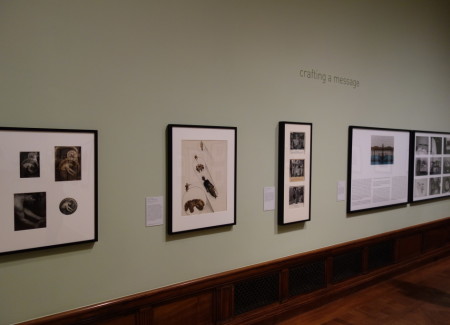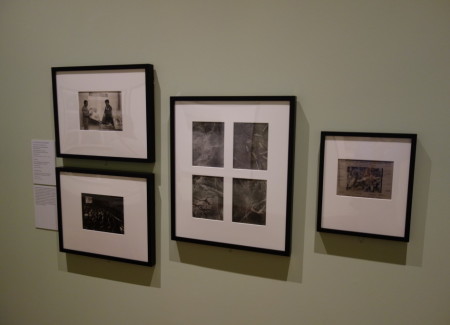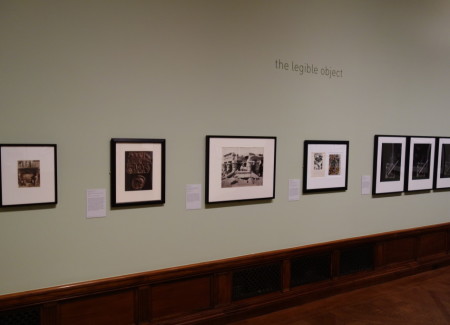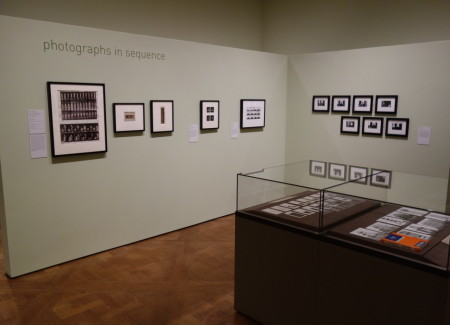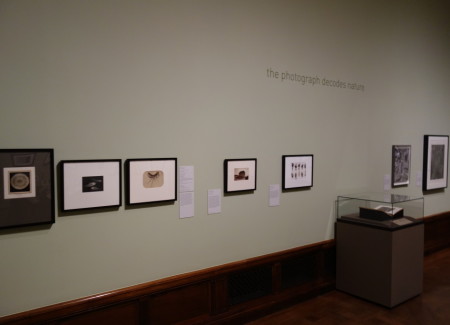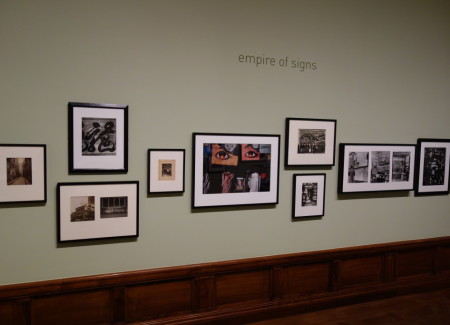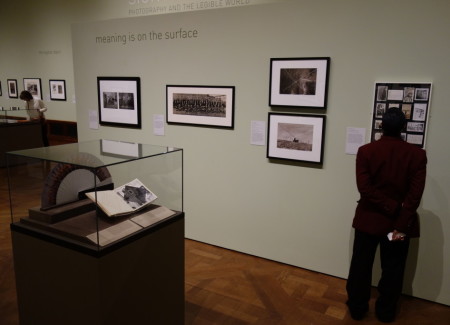JTF (just the facts): A group show containing a total of 154 photographs from 72 different artists/photographers, variously framed and matted, and hung against light green walls in a large single room gallery space with multiple dividing walls. The show was curated by Joel Smith (from the Morgan Library) and Lisa Hostetler (from the George Eastman Museum), with many of the works on view drawn from the Eastman collection.
The exhibit is divided into thematic sections. The following artists/photographers have been included in each titled section, with the number of works on display, their processes and dates as background:
The Camera Takes Stock
- William Henry Fox Talbot: 1 salted paper print from albumen negative, c1843
- Nina Katchadourian: 1 chromogenic print, 2012
- Harold Edgerton: 1 gelatin silver print, 1936-1950
- Timothy O’Sullivan: 1 albumen print, 1973
- Aimé Laussedat: 1 albumen silver print, 1861
- NASA/US Geological Survey: 1 photomosaic of 109 gelatin silver prints, 1967
- John Pfahl: 5 Ektacolor prints, 1993
Crafting a Message
- Lewis Hine: 4 gelatin silver prints, 1920
- László Moholy-Nagy: 1 collage with pencil, 1927
- Photometric Corporation: 3 gelatin silver prints, 1942-1948
- Sophie Calle: 1 silver dye bleach print diptych with an array of 9 gelatin silver prints, 1983
- US Army/US Army School of Aerial Photography/Unidentified: 7 gelatin silver prints, 1916, 1918
The Legible Object
- David Octavius Hill and Robert Adamson: 1 salted paper print from calotype negative, c1845
- Jean-Louis-Henri Le Secq: 1 salted paper prints from waxed paper negative, 1854-1855
- Francis Frith: 1 albumen print, c1863
- Richard Sharpe Shaver: 2 gelatin silver prints with typed text and colored marker, 1970, 1972
- John Baldessari: 3 gelatin silver prints, 1974
- Jean-Pierre Ducatel: 4 gelatin silver prints, 1966
- Jonathan Lens: 6 inkjet prints, 2003
- Nickolas Muray: 1 carbro print, 1945
- Robert Cumming: 1 inkjet print, 1997
Photographs in Sequence
- Eadweard Muybridge: 2 gelatin silver printing out paper prints, 1885
- Étienne-Jules Marey: 2 albumen silver prints, 1889, 1890
- Frank B. Gilbreth: 2 sets of gelatin silver prints on stereographic mounts, 1913, 1917
- Marion Faller/Hollis Frampton: 1 gelatin silver print, 1975
- Duane Michals: 7 gelatin silver prints, 1975
- William Jennings: 14 gelatin silver prints mounted to notepad paper, c1887
- Bernd and Hilla Becher: 9 gelatin silver prints in presentation box, 1968
Photography and the Page
- Lewis Hine: 2 gelatin silver prints, 1905
- Paul Nadar: 1 photomechanical reproduction (containing multiple images), 1889
- Claude Cahun: 1 gelatin silver print, 1936
- John Heartfield: 1 rotogravure, 1935
- William Larson: 1 electro-carbon print, 1976
- Joan Fontcuberta: 1 silver dye bleach print, 1999
- Stephen Henry Horgan: 1 photomechanical printed page, 1 lithograph, 1880, 1928
- Pierre Cordier: 1 chemigram, 1964-1978
The Photograph Decodes Culture
- Frank Stofflet: 1 albumen silver prints on paper mat, 1892
- Unidentified: 1 tintytpe on paper mount, c1874
- Unidentified: 1 albumen silver print, 1862
- Timothy O’Sullivan: 2 albumen silver stereographs, 1864
- GW Thorne/Francois Willeme: 1 albumen silver stereograph, c1865
- Unidentified: 1 albumen print, c1875
- Huston & Kurtz: 1 gelatin silver on printing out paper print, c1865
- Francois Willeme: 4 albumen silver prints, c1865
- Aaron Siskind: 5 gelatin silver prints, 1952, 1955
- Juergen Ruesch/Weldon Kees: 1 book, 1956
- Fazal Shiekh: 1 book, 2015
The Photograph Decodes Nature
- Frederick H. Evans: 1 gelatin silver print, 1887
- Dr. Josef Maria Eder/Eduard Valenta: 1 photogravure, 1886
- Adolphe Neyt: 1 albumen silver print, c1865
- William Henry Jackson: 1 albumen silver print, 1870
- Frederick Sommer: 1 gelatin silver print, 1938
- Dr. James Deane: 1 book, 1861
- William Garnett: 1 gelatin silver print, 1955
- Maurice Loewy/Pierre Henri Puiseux: 1 photogravure, 1903
Empire of Signs
- Eugène Atget: 1 albumen silver print, c1908
- Brett Weston: 1 gelatin silver print, 1970
- Alliance Commercial Photo: 2 gelatin silver prints, 1918
- John Thomson: 1 woodburytype, 1877
- Alex Webb: 1 chromogenic development print, 1981
- Margaret Bourke-White: 1 gelatin silver print, 1937
- Ferenc Berko: 1 gelatin silver print, 1946
- Andreas Feininger: 3 gelatin silver prints, 1940
- Aaron Siskind: 1 gelatin silver print, 1951
The Meaning is on the Surface
- Unidentified: 14 gelatin silver prints with inscription, 1920s-1050s
- Thomas Barrow: 2 gelatin silver prints, 1974, 1976
- Gravelle Studio: 1 gelatin silver print, 1920
- Robert Cumming: 2 gelatin silver prints with pen additions, 1975
- Pierre David: 1 book, 2014
- Keith Smith: 1 book: 1989
(Installation shots below.)
Comments/Context: One of the subtlest and yet most profound consequences of the smartphone revolution is how it is radically changing our habits of communication, and most particularly, how photography has taken over as a full-blown language of its own. Starting with Instagram and later exploding with Snapchat (and other like services), we have seen images become the primary point of daily communication, often without any text captioning or explanatory words – images are increasingly speaking for themselves, with facial expressions, filters, and common gestures becoming a meta-language of signifiers and symbols we use to express our 21st century selves.
We all speak this visual language to some extent, and yet very few of us have any formal education in the language of photography. Instead, we have absorbed via casual osmosis and cultural participation the grammar, syntax, and other “rules” of this language, or simply learned by social trial and error how to use a photograph to communicate what we feel. Think of the millions of teenagers out there using Snapchat to stay connected, and very, very few of them has any structured education in how photography actually functions – we teach our kids analytical and critical thinking skills using words and numbers, but almost never apply these same techniques to photographs.
Which brings us to the Morgan Library’s new Sight Reading exhibition. Perhaps as a result of having a relatively uneven permanent collection of photography, the Morgan has charted an altogether original course for bringing photography into its exhibition offerings – in every exhibit since the founding of the department just a few years ago, thoughtful and sophisticated education about the functioning of photography has been front and center. Curator Joel Smith’s first show A Collective Invention (here) used visual echoes to connect photographs of all different kinds in a linked daisy chain of subject matter, compositional approaches, and thematic ideas – it was a “photography first” show, one that minimized the centrality of the maker in favor of the structure and content of the images themselves. In a sense, he was teaching us how to look closely at what a photograph had to offer, without getting bogged down in famous names we were supposed to like – vernacular photographs and pictures by unidentified makers could be just as compelling as those produced by bold faced names, and photographs could be connected in a seemingly endless variety of ways if we were open to letting them talk to each other. The museum’s second show focused on the work of Emmet Gowin (here), but instead of the usual retrospective march, it placed Gowin’s photographs in the context of a smorgasbord of artistic material he had found compelling or influential. It showed us plenty of master photographs of course, but it forced us to see those endpoint pictures in the context of how an artistic mind functions – it too was a show full of echoes and parallels, expanding our thinking about how photography was intimately (and inherently) related to other artistic mediums.
Sight Reading takes this deliberate progression of photographic education a step further. Using the depths of the collections of the George Eastman Museum as a backstop for the Morgan’s smaller holdings, it shoehorns nine thematic frameworks into the space of one room, using a handful of photographs to illustrate and embellish each one. With unexpected combinations and playful wit, it walks us through the equivalent of a series of short visual “lectures” (I’m sure the curators will loathe that analogy), each with its own quick lesson about how a photograph might function and supporting examples that succinctly fill out the breadth of the idea. For the most part, these themes and concepts are sized just right, with just enough backup to make the point without the idea becoming a bludgeoning tool.
The best of these mini-lectures are tightly defined, and that specificity makes their visual arguments easier to follow. In one, we see how photography can be used to measure and document things, from William Henry Fox Talbot’s arrays of china and Timothy O’Sullian’s Spanish inscriptions (complete with ruler) to complex NASA moon surface collages and John Pfahl’s conceptual markings on the beach to measure waves. In another, we see how sequences of photographs can build out the ideas of elapsed time, side-by-side comparison, and step-by-step storytelling, with stop motion studies by Eadweard Muybridge and Étienne-Jules Marey, typologies of lightning strikes and industrial buildings by William Jennings and Bernd and Hilla Becher, and cleverly sequenced narratives by Duane Michals and Marion Faller/Hollis Frampton providing succinct and conclusive evidence for each approach. Other strong subjects include how cropping, changes of perspective, and collage techniques can help to build a multi-layered visual narrative, and how photography has been used to interrogate nature (and what those questions/answers look like), from photomicrographs and up close still lives to wide screen aerials and space imagery.
Several of the other sections turn photography back toward its long interaction with the written word. We study different forms of visual legibility, from photographs of inscriptions, coins, and hieroglyphs in indecipherable scripts to more modern issues of color calibration and pixelization. We think about how photography functions when it is transferred to the printed page, from Paul Nadar’s “photographic interview” for a newspaper to Joan Fontcuberta’s mind-bending photograph of a text printed in the raised dots of braille (stop for a second and savor his reversal – an image of something that blind people use to read, but which, as a visual image, is unreadable to blind people). And we see how surface markings, from inscriptions and signatures to hand drawn additions and x-outs, can modify (and transform) an underlying photograph, just like digital squiggles and decorative visual filters do now.
If I’m making this exhibition sound plodding and tedious, as “photography education” might sound to many, I’ve failed – it’s just the opposite, with most sections of the show crisp and well plotted, so that we get the point without undue pontificating, perhaps with a quirky visual twist or two thrown in to prove the conclusion isn’t meant to be dull. This is a show that can be savored in torn off chunks, and likely one where one or two ideas will resonate particularly strongly with any one visitor.
In the end, Sight Reading is the kind of show I would like to get my Snapchatting teenagers to go and see, as if they took the time to really look, I think they’d come away with a more nuanced view about how many different ways photography can be used to communicate complex ideas. While an open mouthed selfie with added rainbow barf certainly has its place in the new visual vocabulary, this exhibit offers tangible examples of other approaches to photographic communication that might be used just as effectively. In our fast moving digital age, basic photographic literacy has become a core requirement, not an elective, and this show is the kind of engaging first level primer that can encourage further thinking.
Collector’s POV: Since this is a museum show, there are of course no posted prices. Given the broad diversity of work collected in this group show, we will forego our usual analysis of individual photographers, their gallery relationships, and their secondary market histories.

